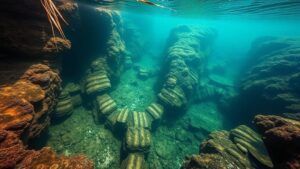Searching for the ceremonial purpose of the sunken moai statues off Easter Island.
The Ceremonial Purpose of the Sunken Moai Statues off Easter Island
Easter Island, known as Rapa Nui, is famous for its enigmatic moai statues, which have captivated the imaginations of historians, archaeologists, and tourists alike. Among these monumental creations, recent discoveries of sunken moai have brought forth a renewed interest in understanding their ceremonial purposes. This article delves into the historical context, significance, and implications of these submerged statues.
Historical Background of the Moai Statues
The moai are large stone figures, primarily carved from volcanic tuff, that were constructed by the Rapa Nui people between the 13th and 16th centuries. Traditionally, these statues are believed to represent the ancestors or high-ranking individuals, forming a crucial part of the islanders cultural identity.
Initially, it was thought that the moai were erected on ceremonial platforms called ahu, which served as tombs for the individuals depicted. But, the discovery of moai that have sunk or been submerged raises questions about their intended placement and significance.
The Discovery of Sunken Moai
In the late 20th century and early 21st century, underwater archaeological expeditions around Easter Island revealed considerable evidence of moai that had sunk into the ocean. Notably, in 2008, researchers uncovered a large group of these submerged statues located near the coast. Studies suggest that over time, natural erosion, tectonic activity, and rising sea levels contributed to their descent below the waterline.
Ceremonial Functions of the Sunken Moai
While the precise ceremonial purpose of the sunken moai remains a subject of ongoing research, several theories have emerged based on historical anecdotes, oral traditions, and archaeological findings. Here are some key considerations:
- Representation of Ancestors: It is posited that these submerged moai may symbolize ancestors who continue to watch over their descendants, even in death.
- Water as a Spiritual Element: Water holds significant spiritual meaning in many cultures. The placement of moai in the ocean could reflect a belief that the water serves as a conduit for connecting the physical and spiritual realms.
- Ritualistic Offerings: The presence of sunken moai may have been part of ceremonies involving offerings, where the ocean served as an altar of sorts for rituals aimed at appeasing the spirits of the ancestors.
Archaeological Insights and Findings
Recent archaeological work, including dives and submersible explorations, has allowed researchers to study the sunken moai more closely. For example, a 2021 study published in the journal Antiquity provided insights into the construction techniques and positioning of these statues, revealing that some were intentionally placed in shallow waters, which may have been associated with ritual practices.
Real-World Applications and Cultural Heritage
The sunken moai offer invaluable insights not only into the Rapa Nui culture but also into contemporary discussions about cultural preservation. Understanding these submerged statues allows for better conservation strategies that protect both the historical and archaeological integrity of Easter Island. Plus, engaging local communities in these efforts can foster a renewed sense of pride and ownership over their cultural heritage.
Conclusion and Actionable Takeaways
The exploration of sunken moai off the coast of Easter Island opens doors to understanding the rich cultural tapestry woven by the Rapa Nui people. Although the ceremonial purposes of these submerged statues are still being deciphered, studying them through an archaeological lens allows us to appreciate their profound significance.
Individuals interested in supporting cultural heritage preservation can:
- Participate in guided tours of Easter Island that include educational content on moai.
- Contribute to or volunteer with organizations focused on archaeological research and conservation efforts.
- Advocate for sustainable tourism that respects and preserves the cultural history of the island.
Engaging with the history and significance of these sunken statues enhances our understanding of human connection to the past and the enduring significance of heritage in contemporary society.



